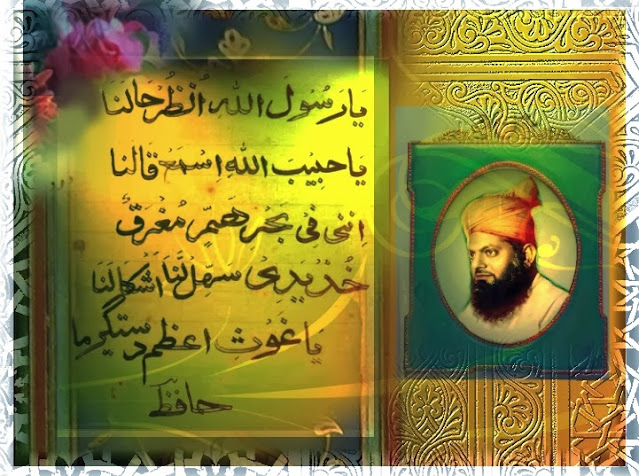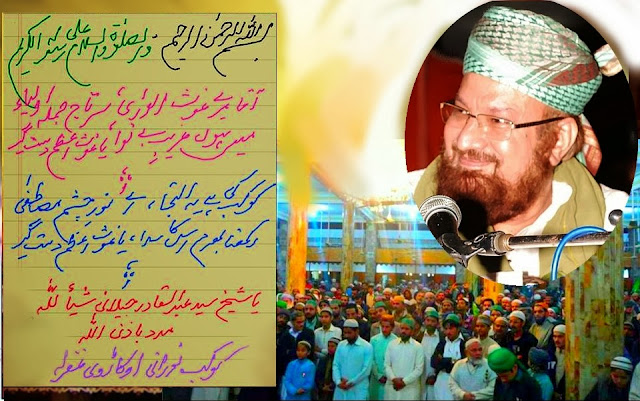Showing posts with label #Saint. Show all posts
Showing posts with label #Saint. Show all posts
Thursday, November 26, 2020
Wednesday, November 18, 2020
Saturday, December 15, 2018
Hazrat Ghaus e A'zam Shaiekh Saiyyid Abdul Qaadir Jeelaani [Rahmatul Laah Alaieh]
There are different duties of the Auliyaa Allaah and they have been blessed differently. We don’t understand. There are 124 000 different degrees of Friendship Of Allaah Kareem [Wilayat] and every one of them is on the footsteps of a Rasoolul Laah [Sallal Laahu Alaieh Wa Sallam]. Therefore it is said, ‘Only a Walee is able to recognize a Walee’.
Speech Excerpt- Hazrat Maulana Muhammad Shafee Okarvi [Rahmatul Laah Alaieh]
Life Events Of Hazrat Ghaus e A'zam Shaiekh Saiyyid Abdul Qaadir Jeelaani [Rahmatul Laah Alaieh]
Excerpt speech by Hazrat Maulana Shafee Okarvi[Rahmatul Laah Alaieh]-South Africa
At the latter stages when Ghaus Paak [Rahmatul Laah Alaieh] reached the level of Ghausiyat a thief broke into his house and the disciples’ caught him. They took him to Hazrat Ghaus al-A’zam [Rahmatul Laah Alaieh] who questioned him as to why he came to steal. The thief replied that he thought many expensive gifts must be brought here since many of the nobles visit this house. He went on to explain that as soon as he put his foot in the house he went blind, was caught .....He pleaded for forgiveness. Hazrat Ghaus al-A’zam [Rahmatul Laah Alaieh] asked him to sit until he finished reading his Wazeefaa. The robber repented sincerely in his heart whilst sitting there in apprehension that the disciples would beat him. Why should he have not repented seeing that he had come to an Aastanaa of such a high spiritual standing. As soon as Hazrat finished his Wazaaif [plural of Wazeefaa] he performed his late night prayer [Tahajjud], lifted his hand for Dua and looked towards the thief. These Auliyaa are overflowing with compassion and grace. Hazrat Ghaus al-A’zam [Rahmatul Laah Alaieh] said, ‘O Allaah Kareem! If this thief went to a materially rich individual he would have got something for his efforts, how can I send him back empty handed. He came to get the riches of this world, but I pray you give him the wealth of Islaam. He came for temporary [Faani] wealth, You give him everlasting [Baaqi] wealth. His physical eye has become blind, O Allaah Kareem ! Restore not only his physical eyesight but open his inner eye [Baseerah]’
It was the last third of the night, the time of acceptance of Dua and this was the Dua of Abu Muhammad Abdul Qaadir Hazrat Ghaus al-A’zam Mahboob e Subhaani [Rahmatul Laah Alaieh] so it was definitely answered. Allaah Kareem ! Restored his sight and granted him spiritual sight. He now looked up to the preserved tablet [Al-lauw Al Mahfooz]. He fell on the feet of Hazrat Ghaus al-A’zam [Rahmatul Laah Alaieh] and begged to be admitted as his disciple and servant. He was initiated into the spiritual order and at the same time granted commission as a spiritual successor [Khilaafat]. Before the Azaan for the Fajr Salaah, Hazrat Khizr [Alaiehis Salaam] came and informed Hazrat Ghaus al-A’zam [Rahmatul Laah Alaieh] that the spiritual head [Qutb] of a certain area had died. Hazrat appointed the very person as the successor to the Qutb of that area. The man came as a thief but left as a Qutb....Sub Haan Laah...
to be continued IN Shaa Allaah.!Thursday, June 29, 2017
1st Jumaadi ul Uulaa: 5 Shawwal Hazrat Shaiekh Sa'di Sheeraazi [Rahmatul Laahi ‘Alaieh]
1st Jumaadi ul Uulaa: 5 Shawwal
Hazrat Shaiekh Sa'di Sheeraazi [Rahmatul Laahi ‘Alaieh]
Bismil-Laahir-Ramaa-Nir-Raheem
ﺍﻟﺼﻠﻮۃ ﻭ ﺍﻟﺴﻼﻡ ﻋﻠﯿﮏ ﯾﺎ ﺳﯿﺪﯼ ﯾﺎ ﺭﺳﻮﻝ ﺍﻟﻠﻪ
ﻭ ﻋﻠﯽ ﺍﻟﮏ ﻭ ﺍﺻﺤﺎﺑﮏ ﯾﺎ ﺳﯿﺪﯼ ﯾﺎ ﺣﺒﯿﺐ ﺍﻟﻠﻪ
Labels:
#Auliya,
#Iran,
#Islam ,
#islamic,
#Muslim,
#Poet,
#Quote,
#saadi,
#Sadi,
#Saint,
#ShaiekhSaadi,
#ShaikhSaadi,
Aulia,
Auliyaa Allaah,
Hazrat Shaiekh Saadi [Rahmatul Laah Alaieh],
Quotes,
Saadi
Thursday, April 20, 2017
Wednesday, May 25, 2016
Wednesday, March 30, 2016
Hazrat Maulana Jalaal ud deen Ruumi (Rahmatul Laahi ‘Alaieh)
Hazrat Maulana Jalaal ud deen Ruumi (Rahmatul Laahi ‘Alaieh)
and his mausoleum on the reverse of the 5000 Turkish lira banknotes of 1981–1994.
5th Jamaadi ul Ukhraa:Hazrat Maulana Jalaal ud deen Ruumi (Rahmatul Laahi ‘Alaieh)
The mausoleum, of Hazrat Maulana Jalaal ud deen Ruumi (Rahmatul Laahi is located in Konya, Turkey.It was also the dervish lodge (tekke) of the Mevlevi order.
Sultaan 'Ala' al-Din Kayqubad, the Seljuk sultaan who had invited Maulâna to Konya, offered his rose garden as a fitting place to bury Bahaa' ud-Den Walad (also written as Bahaa ud deen Valed), the father of Maulâna, when he died on 12 January 1231. When Maulâna died on 17 December 1273 he was buried next to his father.
His successor Hüsamettin Çelebi decided to build a mausoleum over his grave of his master. The Seljuk construction, under architect Behrettin Tebrizli, was finished in 1274. Gürcü Hatun, the wife of the Seljuk Emir Suleyman Pervane, and Emir Alameddin Kayser funded the construction. The cylindrical drum of the dome originally rested on four pillars. The conical dome is covered with turquoise faience.
However several sections were added until 1854. Selimoğlu Abdülvahit decorated the interior and performed the woodcarving of the catafalques.
The decree of 6 April 1926 confirmed that the mausoleum and the dervish lodge (Dargaah) were to be turned into a museum. The museum opened on 2 March 1927. In 1954 it was renamed as "Maulâna Museum".
One enters the museum through the main gate to the marble-paved courtyard. The (washing fountain) in the middle of the courtyard was built by Yavuz Sultan Selim.
One enters the mausoleum and the small mosque through the Tomb gate.Its two doors are decorated with Seljuk motifs and a Persian text from Abdurrahman Cami dating from 1492. It leads into the small Tilaawat Room decorated with rare and precious Ottoman calligraphy in the different styles. In this room the Quraan was continuously recited and chanted before the mausoleum was turned into a museum.
One enters the mausoleum from the Tilaawat Room through a silver door made, according to an inscription on the door, by the son of Mehmed III in 1599. On the left side stand six coffins in rows of three of the dervishes who accompanied Maulâana and his family from Balkh. Opposite to them on a raised platform, covered by two domes, stand the cenotaphs belonging to the descendants of the Maulâna family (wife and children) and some high-ranking members of the Mevlevi order.
The coffin of Maulâna is located under the green dome.It is covered with brocade, embroidered in gold with verses from the Quraan. This, and all other covers, were a gift of sultaan Abdul Hamid II in 1894. The actual burial chamber is located below it. Next to Maulâna's sarcophagus are several others, including the sarcophagi of his father Bahaeddin Veled and his son Sultan Veled. The wooden sarcophagus of Maulâna dates from the 12th century now stands over the grave of his father. It is a masterpiece of Seljuk woodcarving. The silver lattice, separating the sarcophagi from the main section, was built by Ilyas in 1579.
The Ritual Hall was built under the reign of Sülaimaan the Magnificent at the same time as the adjoining small mosque. All the display in this room, together with an ancient Kirşehir praying rug (18th century), dervish clothes (Maulâna's included) and four crystal[citation needed] mosque lamps (16th century, Egyptian Mameluk period). In this room one can also see a rare Diwaan-i-Kebir (a collection of lyric poetry) from 1366 and two fine specimens of Masnavi (books of poems written by Maulâna) from 1278 and 1371.
Source-Wikipedia
Monday, March 28, 2016
Hazrat Maulana Jalaal ud deen Ruumi (Rahmatul Laahi ‘Alaieh)
Hazrat Maulana Jalaal ud deen Ruumi
(Rahmatul Laahi ‘Alaieh)respectfully as Maulana ("our Master"), is a thirteenth-century Persian Soofie Saint Auliyaa Allaah, jurist, theologian, poet and one of the greatest spiritual masters of Islaam. He was known as Ruumi because he spent most of his life in the region known by Muslims as "Ruum," the Anatolian peninsula most of which had been conquered by the Seljuq Turks after centuries of rule by the Roman Empire.
He is acknowledged as the father of one of Islaam’s major Soofie orders, the Mevlevi order although its actual inception came about through his disciples. He was also often referred to by the Persian title, the ("great Master")...
Tuesday, March 15, 2016
Hazrat Maulana Jalaal ud deen Rumi
Hazrat Maulana Jalaal ud deen Ruumi
(Rahmatul Laahi ‘Alaieh)respectfully as Maulana ("our Master"), is a thirteenth-century Persian Soofie Saint Auliyaa Allaah, jurist, theologian, poet and one of the greatest spiritual masters of Islaam. He was known as Ruumi because he spent most of his life in the region known by Muslims as "Ruum," the Anatolian peninsula most of which had been conquered by the Seljuq Turks after centuries of rule by the Roman Empire.
He is acknowledged as the father of one of Islaam’s major Soofie orders, the Mevlevi order although its actual inception came about through his disciples. He was also often referred to by the Persian title, the ("great Master").....to be continued In Shaa Allaah.
Sunday, March 13, 2016
Auliyaa Allah
Alaa Hazrat Imaam Ahmad Razaa Khaan Bareillvi
[Rahmatul Laahi Alaieh] the Mujaddid of his Time...the Savior of Ahle Sunnat Wa Jamaa'at love...&
His Principles
1. Love of Allaah Kareem and His Beloved Prophet Muhammad [Sallal Laahu Alaiehi Wa Sallam] is before anything & everything
He said “If my heart was ever divided into two parts, one of them would have written on it “laa ilaahaa Illal Laah” and on the other “Muhammadur Rasoolul Laah”!!
He did not tolerate blasphemy (disrespect) of the Noble Prophet Muhammad [Sallal Laahu Alaiehi Wa Sallam] or of the pious companions or Auliyaa Allaah and stood strongly against the corrupted groups of his time for this reason.
[Rahmatul Laahi Alaieh] the Mujaddid of his Time...the Savior of Ahle Sunnat Wa Jamaa'at love...&
His Principles
1. Love of Allaah Kareem and His Beloved Prophet Muhammad [Sallal Laahu Alaiehi Wa Sallam] is before anything & everything
He said “If my heart was ever divided into two parts, one of them would have written on it “laa ilaahaa Illal Laah” and on the other “Muhammadur Rasoolul Laah”!!
He did not tolerate blasphemy (disrespect) of the Noble Prophet Muhammad [Sallal Laahu Alaiehi Wa Sallam] or of the pious companions or Auliyaa Allaah and stood strongly against the corrupted groups of his time for this reason.
Subscribe to:
Posts (Atom)






















